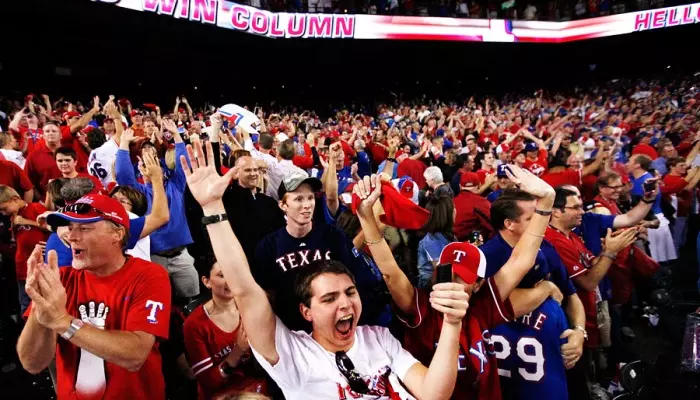Alex Weller and Derek Hitz have returned to Tuscaloosa for their senior year at Alabama with more than a few stories about the challenges of marketing the (Texas) Rangers Rewards credit card inside the stadium and in the community.
Erskine Financial Services Founder Hal Erskine takes pride in his continual engagement with both banks and partners after the contracts are signed, spending time using his 26 years of experience to make sure the program works, including traveling to meet with the program teams, personally selling the card at the kiosk in the stadium, and advising his clients – some of whom have never had an affinity card program — on program-growth strategies.
“In addition to helping my partners optimize their programs, I’m particularly proud of the fact that I’ve invested in more than 30 college students interested in sports marketing and given them a chance to see if this is the business they really want to be in,” says Erskine.
The Bama Boys were asked to do something that many large credit-card issuers have stopped doing for their sports and special-interest programs: Face the rejection of face-to-face selling as fans enter the stadium and walk around during the game. Even with a T-shirt in hand to give away to applicants, it takes a thick skin to get someone to apply for a credit card — even one as strong as the Rangers Rewards card — as parents try to herd the kids to their seats, get some pregame snacks, or just avoid the gauntlet of other people hawking their products.
The Bama Boys kicked off their summers in stealth mode, heading into the community and passing out thousands of brochures explaining the program throughout the Dallas-Fort Worth area.
But they wanted to take applications too and found some local merchants were reluctant to let them do that. So Rangers Coordinator of Business Partnerships Taylor Addy helped them find some sponsors who would let them table and got them Hot Spots for their iPads. The Bama Boys soon found themselves at some local baseball tournaments and nearby hotels when the Rangers were traveling or during off days on the schedule.
At the same time, the EFS team back home in Delaware was focusing on other important aspects of the program, including pushing for a deeper analysis of lower-than-anticipated approval rates from certain marketing venues; creating table tents promoting the program and providing a URL for applying for the in-stadium restaurants and bars where season-ticket holders gathered before and during the game; providing the Bama Boys with nightly feedback and mentoring on their strategies; and working with UMB Bank to develop training for tabling staff on the compliance niceties around this type of marketing.
In addition, EFS staffer Richard Gaines spent part of his summer creating comparisons of other affinity co-brand programs to identify opportunities to strengthen the program. The Rangers and UMB Bank did their part, adding a cash-back feature during the summer with Erskine’s strong encouragement after receive lots of feedback from in-stadium prospects who said they’d apply if the program offered that.
“Where other financial institutions have decided that face-to-face marketing is not a good way to promote their card programs, I believe that meeting the fans in person is a great way to get them excited and get ideas for how the program can better meet their needs…and if you work hard and learn from your mistakes, you can make the economics work,” Erskine says.
The goal of Erskine’s intern program – beyond exposing the students to the nuts and bolts of sports marketing – is to learn by doing. Weller and Hitz say they’ve learned a few things that other franchises might consider when launching or trying to grow their own program:
- Make it easy for fans to apply by (1) getting their phone numbers and sending them an application link to their mobile devices and (2) getting mobile with handheld iPads that enable you to quickly process applications and secure both a hot spot and WiFi so that you can table outside the stadium in parking lots and at local businesses, including bars and restaurants where fans gather before and after the game.
- Make sure that your tabling staff likes the sport and that they can speak intelligently about the program benefits and redemption items. “Lots of people asked us, ‘What redemption items would you want to earn?’ and we each had our own answers,” says Hitz.
- Find external locations to market so you’re not sitting around during road trips. The Bama Boys saw business pick up once Addy got involved.
- Promote some free (or discounted) redemptions and publicize them inside the stadium. For example, letting an early adopter throw out a first pitch or putting a photo on the Jumbotron of someone doing a Meet and Greet. Ask the team to let fans know where you’re stationed.
- Ask the team to support the program with video for the in-stadium TVs and during in-game announcements.
- Test different tabling locations and move around during the game, since fans only enter the gates once during the game (the last thing they want as they’re leaving is to be asked to fill out a card application). “We had a little notebook to capture times and places for each application so that we knew what worked best when,” says Weller.
- Look for “extras” that the team could offer cardholders. One example might be premium parking for cardholders close to the stadium, regardless of whether you charge them or not.


